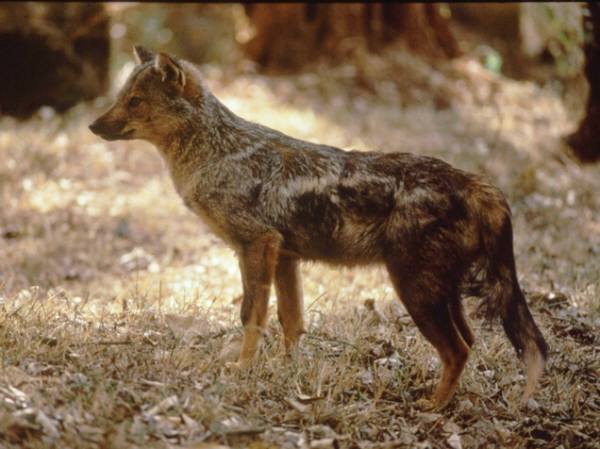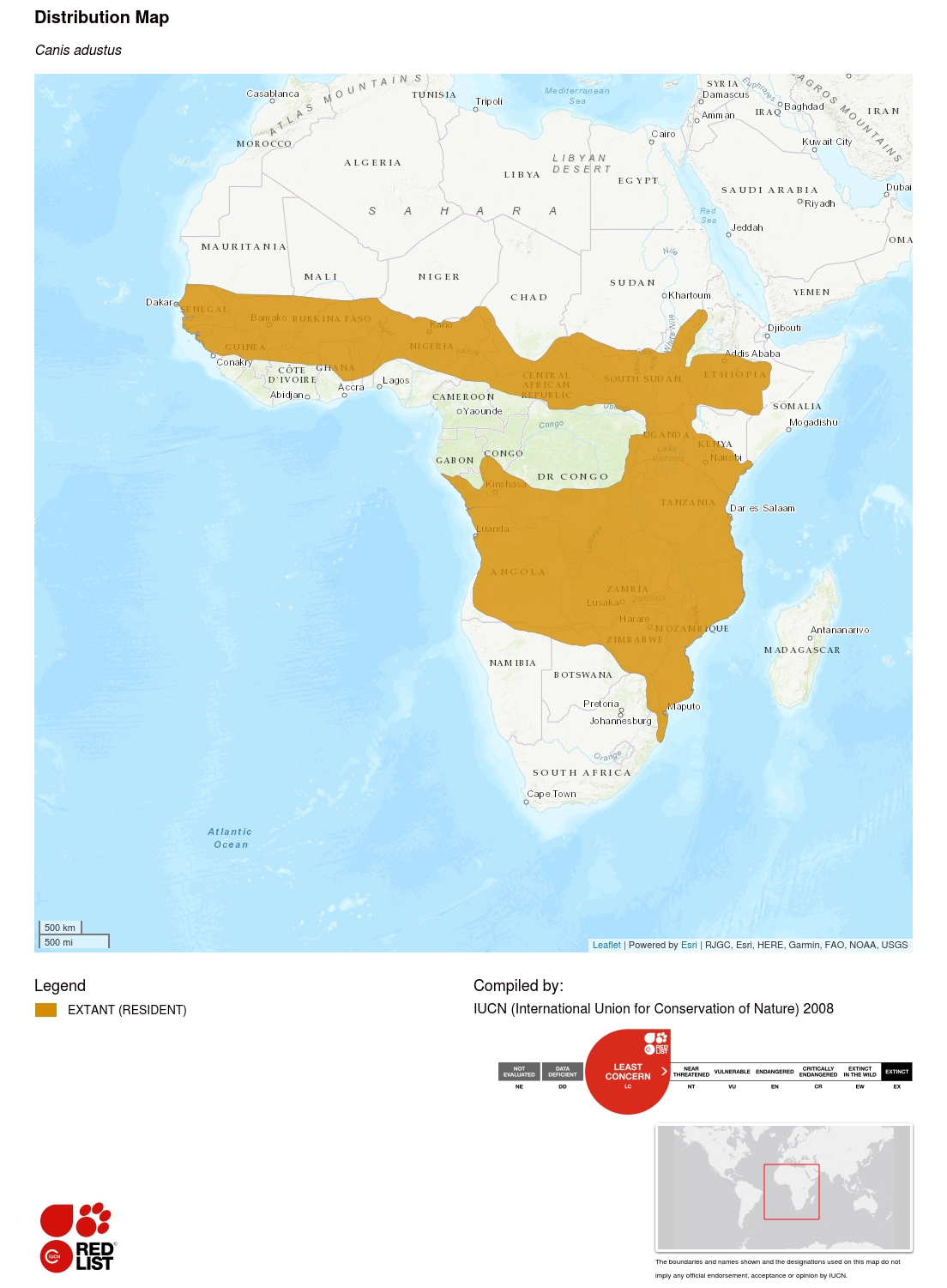
- South America
- Central & North America
- Europe & North/Central Asia
- Sub-Saharan Africa
- North Africa & the Middle East
- South Asia
Sub-Saharan AfricaSide-striped jackal Lupulella adustus

side-striped jackal - © Chris and Tilde Stuart
Relevant LinksReports / PapersOther NamesEnglish: Side-striped Jackal
French: Le chacal à flancs rayés
Afrikaans: Witwasjakkals
German: Streifenschakal

Justification
The Side-striped Jackal occurs widely in sub-Saharan Africa, from West Africa to the horn and south to southern Africa. Regional estimates of abundance are not available, but it seems reasonable to assume the species is common and the population largely stable. This species' dietary flexibility and ability to co-exist with humans on the periphery of settlements and towns suggests that populations are only vulnerable in cases of extreme habitat modification or intense disease epidemics, and high reproductive productivity ensures this species is capable of rapid recovery following population crashes.
Geographic Range Information
The Side-striped Jackal occurs over much of sub-Saharan Africa, from Gambia and Senegal through the Sahelian regions of West Africa to the Horn, and then southwards into southern Africa (where absent or marginally distributed in the more arid westerly regions) (Loveridge and Macdonald 2013). North-eastern KwaZulu-Natal marks its most southerly occurrence on the continent (Rowe-Rowe 1992).
Population trend:Stable

Population Information
Jackal densities are estimated at around 1/km² in highveld commercial farmland in Zimbabwe (Rhodes et al. 1998), where rural density is probably highest; density estimates from western Zimbabwe were between 0.5–0.8 individuals/km² (Macdonald et al. 2004). Densities in West Africa are lower; in Senegal's Niokola-Koba National Park, jackal density was estimated at 0.07/km² (Sillero-Zubiri et al. 1997). This species' dietary flexibility and ability to co-exist with humans on the periphery of settlements and towns suggests that populations are only vulnerable in cases of extreme habitat modification or intense disease epidemics.
Habitat and Ecology Information
Side-striped Jackals occupy a range of habitats, from game areas through farmland to towns within the broad-leaved savanna zones, including wooded habitats, bush, grassland, abandoned cultivation, marshes and montane habitats up to 2,700 m (Kingdon 1977, 1997; Estes 1991). The species tends to avoid very open savanna (although Rowe-Rowe (1992) mentions they occur in open grassland in north-eastern KwaZulu-Natal), thickly wooded areas and arid zones (Stuart and Stuart 1988, Kingdon 1997, Skinner and Chimimba 2005), but Kingdon (1997) states that it enters the equatorial forest belt in the wake of human settlement. Side-striped Jackals frequently occur near rural dwellings and farm buildings (Kingdon 1997, Skinner and Chimimba 2005), and penetrate peri-urban and urban areas (Liebenberg 1990, Skinner and Chimimba 2005). In Botswana, Smithers (1971) recorded them where mean annual rainfall was 400–700 mm, and many authors note that the species occurs in well-watered areas (e.g., Kingdon 1977).
Where Side-striped Jackals occur sympatrically with other jackal species, they may avoid competition by ecological segregation (Fuller et al. 1989). In such areas of sympatry, Side-striped Jackals usually occupy areas of denser vegetation, while Black-backed and Golden Jackals dominate in the more open areas (Loveridge 1999, Loveridge and Macdonald 2003).
Threats Information
Side-striped Jackals are persecuted for their role in rabies transmission and their putative role as stock killers. It is unlikely that this persecution has an effect on the overall population (Bingham and Purchase 2002), but indiscriminate culling through poisoning and snaring could affect local abundance. Side-striped Jackals appear well capable of exploiting urban and suburban habitats, a factor which may help to ensure their persistent occurrence.
Use and Trade Information
There appears to be little or limited trade in jackal products.
Conservation Actions Information
The species is not listed on the CITES Appendices, and jackals have no legal protection outside protected areas. The species occurs in many protected areas across its range, including Niokola-Koba National Park in Senegal, Comoe NP in Côte d'Ivoire, Queen Elizabeth NP in Uganda, Serengeti NP in Tanzania, Hwange NP in Zimbabwe, and Kruger NP in South Africa.
The species has been kept and bred in zoos, but it is not a common zoo exhibit and there are none currently listed on ISIS. Captive animals have been used in experiments testing rabies vaccine efficacy (Bingham et al. 1995).
Studies conducted in Zimbabwe ave gone some way to increasing our understanding of this jackal species, particularly as concerns their role in rabies transmission. However, in comparison with the better-known Black-backed Jackal, the Side-striped Jackal has a much wider distribution, such that there are large parts of their range for which no information on populations or status is available.

